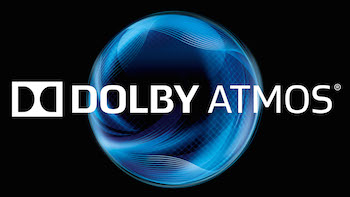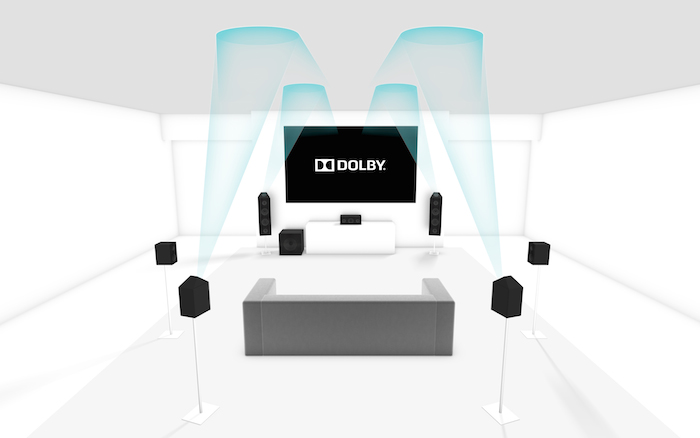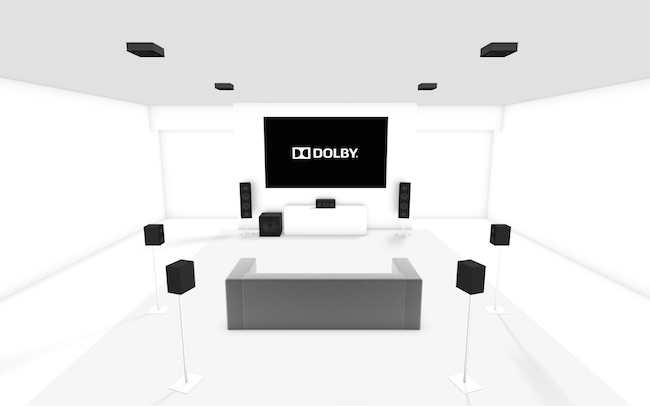Forget UHD TV and 4K... I want my Dolby Atmos!
While most of the narrative in recent years has focused on the dramatic advances in image quaility available to consumers; especially with the advent of UHD TV (aka "4K"), OLED, and curved screens, the reality is that until 4K content becomes readily available to consumers, in both streaming and physical media, it is really not much more than vaporware. On the flip side, advancements in home audio surround technology have made enormous strides of late thanks to Dolby with the introduction of Dolby Atmos, which we have now had almost two years to digest at local movie theaters. This fall that theatrical experience is coming home in the form of new Dolby Atmos-enabled home theater gear.
Dolby hosted a press event this week to fill in some of the missing details and give some live demos of the home implementation of Dolby Atmos. BPBS editor Chris Boylan and I were on-hand at the Dolby Labs in New York to check it out.
Dolby has taken its time with Atmos, but the goal was always to bring the format from the theater into the home. Having had the opportunity to experience Dolby Atmos in theaters on more than one occasion on films such as The Hobbit: An Unexpected Journey, Godzilla, and Guardians of the Galaxy, I would be lying if I pretended that I didn't want to try this immersive format at home.
Atmos may offer a breath-taking auditory experience, but my initial take on the prospect of bringing it home was somewhat cynical: why would consumers want to add additional 8-20 loudspeakers to their existing home theaters and how many divorces would that cause?

At this time, manufacturers who have announced Dolby Atmos A/V receivers or processors include Denon, Integra, Marantz, Onkyo, Pioneer, Steinway Lyngdorf, and Yamaha. Definitive Technology has announced a line of Dolby Atmos enabled speaker modules and Pioneer USA announced Dolby Atmos-enabled speakers designed by legendary speaker designer Andrew Jones. Onkyo has also announced a Dolby Atmos equipped Home Theater in a Box. According to Dolby, there are no Atmos-enabled sound bars on the horizon in the near future, but that could certainly change. More partners will be announcing Dolby Atmos enabled products through the coming months; which will be right in time for the first series of Dolby Atmos titles which should be available around the holidays and at the beginning of 2015.
But why should I add Atmos when I already like my home theater?
Unlike conventional home theater surround sound, Atmos is not based around channels. Huh? If you're scratching your head that is perfectly okay because what Dolby has done is completely rewrite all of the rules when it comes to immersive sound in the home. Dolby came to the realization a number of years ago that even systems with eleven loudspeakers were unable to properly recreate the illusion of immersive sound as long as they kept things in a single plane (horizontal). But as you add more channels in a channel-based system, you start taking up a lot more storage and bandwidth, and you lose the flexibility you'd need for a truly scalable and customizable format.
What if I have a 5.1 system and want to just add a couple of height channels? Or what if I want to really go crazy and do 24 surround channels and 10 height channels (for a really large home theater)? How can a single channel-based surround format satisfy both requirements. It can't.
Dolby Atmos is the first home theater system that is based not on channels, but on audio objects. What is an audio object? Any sound heard in a movie scene -- a child yelling, a helicopter flying around, a car horn blaring -- is an audio object. Filmmakers using Dolby Atmos can decide exactly where those sounds should originate within a three dimensional soundstage and precisely where they move as the scene develops. At playback time, these objects can then be mapped to as many speakers as you have in your particular home theater be that 7 speakers and a subwoofer, or a full blown 34-speaker system.

And those new height speakers don't necessarily have to be put in the ceiling, thanks to some fancy processing work by Dolby. Dolby's new Atmos speaker spec allows a small speaker to be placed on a wall or right on top of your existing speakers, with the driver firing up and bouncing that height channel off the ceiling. The internal Atmos processor gives listeners the illusion of sound coming from above them, fully integrated with the rest of the soundstage. Dolby's Director of Research Brett Crockett said the effort involved in getting these Atmos speakers to perform like discrete ceiling speakers is akin to "hacking our hearing" -- identifying physical and neural queues about how we hear and reproducing these in the decoded signal.
New Atmos speakers coming from Pioneer and Onkyo actually take up the same footprint as a standard tower or bookshelf speaker with a dedicated height speaker built in. Definitive Technology is also planning to release an Atmos speaker module that matches the form factor of their existing tower speakers and will sit discretely on top of them without hurting the overall aesthetics of the system.
At one of the first Atmos demonstrations, Dolby played a short cut of an intense rainstorm, which included thunder and some wind. In a traditional 7.1 surround set-up, the storm sounded impressive but it always felt like it was coming from the four corners of the room; you were not really in the storm. There was this massive void in the middle that made it sound two-dimensional.
With Atmos and its height speakers, you were right in the middle of the storm and as you moved around the theater, the storm moved with you. Dolby played these demos both with traditional ceiling speakers and with the new Atmos speaker prototypes that bounced sounds off the ceiling and I must say results were impressive for both, in terms of creating an immersive soundfield.
In another demonstration with helicopters, the space above your viewing position suddenly becomes the sky and as the helicopter gets closer or further away from you, the impact of the blades either increases or decreases. The intensity of it takes surround sound in the home to another level; and not just in volume level for those who are concerned that Atmos will punish your eardrums. The improvement in detail and even tonal accuracy is rather uncanny.
Sounds cool but what hardware will I need?
To experience Dolby Atmos at home, one really only requires an Atmos-capable receiver or processor, a suitable source (Blu-ray or streaming box) and seven loudspeakers. The basic Atmos configuration would be 5.1.2: five traditional speakers, two height speakers and 1 subwoofer.
While the theatrical implementation of Atmos can support up to 64 speakers, the home implementation is "limited" to only 34: that's 24 surround channels and 10 height speakers. Even the most ambitious home theater project should be satisfied by these specs. Of course, no receiver or processor is available yet that can support this many output channels but Dolby says there is at least one hardware partner that is planning to release an A/V processor with 32 channels in the very near future (we've unofficially heard the brands Trinnov and Steinway Lyngdorf mentioned when these types of conversations have come up).

Unfortunately if you purchased a brand new AVR in late-2013, you are most likely out of luck. Although the Dolby Atmos decoding and processing is being delivered with firmware and software upgrades, the actual processing power required is pretty significant, which rules out most gear already on the market. But in happier news, Onkyo, Pioneer, Denon and Yamaha all did announce that several of their 2014 model year receivers (some of which are already on the market) will be upgradeable via firmware to support Dolby Atmos some time this fall. As always, check with your receiver manufacturer to see if your specific model will get the Atmos upgrade.
As to specific loudspeaker brands that will be releasing Atmos-enabled modules and products that consumers will be able to purchase this year - that list is being kept private for now by Dolby (so as not to steal their hardware partners' thunder), but apparently the list of partners is not small or insignificant. With CEDIA 2014 less than one month away, the proof will be in the actual number of products that are released or announced in Denver.
Will Atmos Become the Next 3D or is this Actually Worth Getting?
From a technical perspective, Dolby Atmos is certainly groundbreaking technology and consumers should expect to see it expand from the cinema into your home theater and then, eventually into mobile technology that will include smart phones, tablets, and headphones.
The $64,000 question still remains - Have consumers given up on dedicated surround sound systems and accepted soundbars as their benchmark for TV and movie sound (sad but very possible)? And will retailers actually do what it takes to properly demonstrate Dolby Atmos? That last bit is very important as a good demo is really the only way to sell the technology and justify the expense. From our perspective, Dolby Atmos is not a gimmick but a revolutionary leap forward for sound quality across different platforms. Existing 5.1 or 7.1 surround set-ups can be upgraded with 2-4 ceiling loudspeakers or modules and a Dolby Atmos-certified AVR and you're done. Just add software. Will consumers bite? We hope that they do because this technology is well worth the audition. Color us genuinely excited about a home theater platform for the first time in many years.
For more information about Dolby Atmos